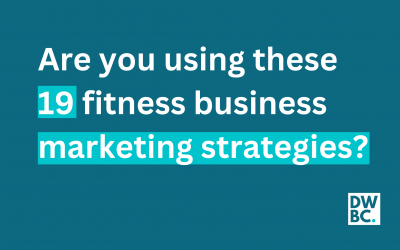Of all the fitness businesses I work with, there is a single strategy that disproportionately increases client retention. This one trick, which takes less than 10 minutes a week, has done more to retain clients and members than any other method of client retention.
Not only does it keep clients, but it shortens your list of clients with memberships on hold.
It’s simple. Each week, contact every customer who has shown an unexplained reduction in training frequency that week.
Cancellations of PT sessions, lack of class attendance, or an uncharacteristic sleep in by a member of the 5.30am open gym training crew? These are all red flags.
What we’re looking for here are breaks of pattern. Deviations from a customer’s usual habits.
When these red flags start to wave, we need to take notice. They can signal that someone’s healthy habits may be beginning to falter. Their habits are starting to leak. We need to plug these leaks before the dam breaks.
It’s much easier to fix small cracks and steer people back on track, than it is to rebuild the dam and a whole new set of habits.
Maybe there’s a reason for their change in behaviour that week. Maybe they’re not sleeping well. Maybe they’ve got a niggly shoulder thing going on. But each of these is an opportunity for you to help that person. Reaching out to them is the first step to helping. It can start a conversation around sleep hygiene, or training modification and rehab for that shoulder injury.
Of course, sometimes people are just having a bad week, and a change in behaviours isn’t indicative of ongoing behaviour change. But in cases like that, it’s no less important to check in on people. In fact, it’s probably even more important. We all have bad weeks. They suck. And a friendly text or call might be the spark we need to turn around our week. Knowing that someone cares enough to reach out can be a game changer. And aside from the simple human decency and kindness this act demonstrates, kindness is also good for business. When we hire staff, kindness is the most important attribute we hire for.
The first step in creating this system is actually being aware of a change in attendance. The easiest way to do this is through some sort of customer relationship management software, or CRM. If your system allows, you need to set up alerts that trigger a notification based on a criteria you define. Maybe the trigger is activated for every client who doesn’t book into a class in a certain week. A more tech-centric approach like this works well for bigger businesses, where the person doing the contacting doesn’t know the weekly attendance patterns of each client.
Or maybe you go super old school, and simply scroll through a spreadsheet of customers and contact everyone you haven’t seen that week. This more analogue strategy is more appropriate for smaller businesses where the person doing the contacting is fairly entrenched in the day-to-day operations of the business, with a close knowledge of the clients.
Regardless of what your trigger is, and how you’re notified about it, you need to be consistent. And while systems and automation are important, there are times in service-based businesses where there’s no replacement for a human approach.
Keep the communication personal, not generic or automatically generated. I’d recommend a text message, or even phone call, which both come across as much more personal than an email or social media contact.
The message doesn’t have to be long, but it does have to be personal. Something like “Hey Jess, the 7pm class missed you on Wednesday. I know you’ve got exams coming up, but just checking in to make sure everything’s ok. Can I let the crew know you’ll be back in action next week?”.
The message will take you no more than 60 seconds to write, and can be a game changer for your business.
Set yourself a reminder for every Friday morning. Reach out to you members. It might be the most valuable minutes of your week.
Not only does this strategy retain clients, but it’s an upstream action you can take to reduce the number of memberships on hold.
And we can’t talk about retention communication without discussing these paused memberships, or memberships on hold. Hopefully you don’t have too many of these, because you weekly text messages should minimise them. But if you do have a growing list of pauses, make sure you’re communicating with them too. Every second week, reach out to check in on how they’re going. Nothing sales-based or pushy, just a friendly ‘touch base’ so they know you care.
And don’t forget ex clients. They should be part of your email network, where you send fortnightly educational content. No one in your network should go longer than two weeks without some form of communication that brings you to the front of mind.
Now, you might remember, I started off by saying that a system to identify red flags and contact customers who have missed sessions or reduced attendance is the most important strategy for retention. But I think I need to clarify this, and maybe rethink my position.
Because there’s another strategy that is hindsight is actually even more important.
Being good. Begin really, really good. Providing an experience to your clients and members that makes you an absolutely indispensable part of their life. An experience that they could never dispense with, regardless of geography or finances.
As comedian Steve Martin said in an interview, and as Cal Newport titled his book, ‘be so good they can’t ignore you’.
There is no better retention technique than being indispensable.
Ask most Fitness Professionals what their product is and they’ll tell you something like ‘Personal Training’.
I’m here to tell you that the product isn’t the Personal Training session you provide. Sure, that’s a big part of the product, but it’s not the whole thing. What you’re REALLY providing is an EXPERIENCE.
The experience is the sum total of contact and interaction with you and your business. Your product isn’t just about what you do for them, or even about how you help them. Your product is about how you make people FEEL.
In fact, so important is this need to provide an experience, that I think, for Fitness Professionals at least: The experience IS the product.
Within this overall experience, or what we can call the ‘Macro Product’, we can have multiple ‘Micro Products’. This is where we’d place things like the physical weekly one-on-one session with your client. A small piece of the puzzle.
From their initial awareness of your brand, the first time they reach out for help, their transition to a paying client, right through to long term retention and referral, every point of contact combines to create their experience. Every point on their client journey (a process you should have systemised) is part of the product you’re providing.
So are you selling exercise, or are you providing an experience?
If your retention is suffering, start there. Make your experience exceptional before you even consider doing anything else.
Let’s wrap it up. There are four things you need to action.
One. Build a system to notify you when clients miss sessions.
Two. Contact these clients to get them back on track.
Three. Contact any paused memberships every fortnight.
Four. Provide an experience for your clients that’s so good, they can’t ignore you.
Do these four things, and not only will your retention rate skyrocket, but you’ll solid your role as a ‘purpose-driven business’ that makes a positive change in the lives of the individuals under your care.





